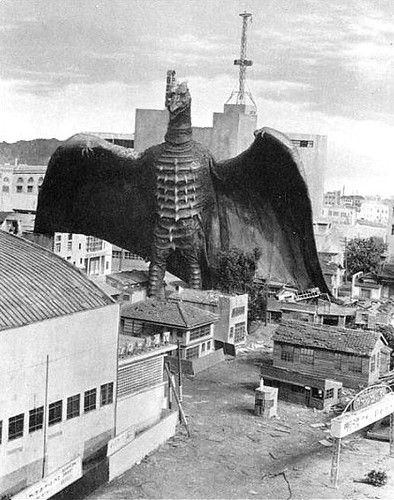
The titular monster amidst the detailed miniature set of Fukuoka.
RODAN, THE FLYING MONSTER
Sora-no Daikaiju Radon, Toho, 1956, 82 minutes
Director ISHIRO HONDA • Visual Effects Director EIJI TSUBURAYA
With the success of the first two Godzilla films under his belt, Producer Tomoyuki Tanaka looked to create a new style of monster movie to be shot in color, and solicited a treatment from mystery writer, Ken Kuronuma, who was the one of the translators for the Japanese edition of Amazing Stories magazine. Kuronuma based the core of his treatment on the unexplained, real-life "Mantell Case" of 1948, in which veteran WW2 pilot, Captain Thomas F. Mantell of the Kentucky Air National Guard, died when his aircraft crashed during the pursuit of an Unidentified Flying Object. Such a scene figures prominently in the completed film, and is cited as one of the most memorable in RODAN — one of Toho's finest genre films.
Set on Japan’s southern island of Kyushu (but mostly shot on location in western Japan), RODAN was Toho's first color kaiju eiga featuring a screenplay, written by Takeshi Kimura and Takeo Murata, which centers on two lovers whom are mirrored with the Rodan. While not appearing in Kuronuma's treatment, the murderous super-sized dragonfly larvae, or Meganuron, were inspired by gargantuan ants in Gordon Douglas' THEM! (1954), and became another memorable element of the film. Honda's direction is solid and dramatic, and much less documentarian than GODZILLA (1954), with truly creepy scenes in the dark and claustrophobic coal mine sets, and beautiful panoramic photography of the breathtaking countryside vistas. Heading up the 2nd Unit was Jun Fukuda (1923-2000), who was promoted to director in 1960 with THE SECRET OF THE TELEGIAN, and later became well-known for his stylish gangster movies and outrageous fantasy films.
Toho trumpeted that RODAN starred the "Hopes for 1957," newcomers Kenji Sahara (b.1932) and Yumi Shirakawa (b.1936), who would be paired in several pictures together after RODAN, including THE MYSTERIANS (1957). After placing second in a Toho talent contest in 1953, Sahara was a bit player until RODAN, and summarily became one of the busiest actors at the studio, appearing in over twenty science fiction films. Still active, Sahara recently appeared in the Tsuburaya Productions television series ULTRAMAN NEXUS (2004). Joining Toho in 1956, the beautiful Shirakawa appeared in several of Honda's pictures, and is still acting today. A favorite of Hiroshi Inagaki and Akira Kurosawa, the late Akihiko Hirata (1927-1984) played "Dr. Kashiwagi" and many memorable roles in Toho fantasy films, starting with "Dr. Serizawa" in GODZILLA. Even today, Hirata continues to be one of the most recognizable faces in the history of the genre.
Tsuburaya's elaborate and spectacular visual effects took up 60% of the film's entire production budget, and it's all up there on screen — from beautiful matte paintings to highly detailed miniature sets — and is still quite effective a half-century later. One of his outstanding sequences is the destruction of the Saikai Bridge, a scene that could only be shot once. A matter of precise timing, his wire operators had to pull the Rodan prop over the 1/20 scale bridge, while other crew members pulled another series of wires to collapse the bridge. Shot with several cameras in tandem (a Tsuburaya technique shared by Kurosawa), it all went off perfectly in one take. The finely detailed miniature of the Iwata-ya department store in Fukuoka City (changed to Sasebo City in the U.S. version) was built with real reinforced steel beams, in order to support the weight of monster actor Haruo Nakajima and the 150-pound Rodan costume. Scenes featuring animation of the flying Rodan being pursued by the fighter plane, or streaking through the skies, are still staggeringly realistic.
Because of the international success of GODZILLA in 1956, the U.S. rights for RODAN were immediately acquired by the King Brothers (Maurice, Frank and Herman), who are today best remembered for RODAN (as well as Eugene Lourie's kaiju eiga-styled GORGO, 1961). Starting with a complete work print, several shots excised in the Japanese version were utilized, while the H-Bomb tests seen at the top of the film came from newsreel footage. The English dialogue was written and directed by David Duncan (1913-1999), best known for THE TIME MACHINE (1960). Voice talent included the venerable Keye Luke (KUNG FU) as "Shigeru" and Paul Frees (THE THING FROM ANOTHER WORLD) as "Nishimura," while a young George Takei, who took RODAN as a summer job — his first acting gig — provided the voice for "Professor Kashiwagi" ("…and at least ten other characters — I lost count!" he recalled). Upon its release in the U.S. in July 1957, RODAN became the highest-grossing science fiction film of that year.
Despite the extensive re-editing of the film (approximately ten minutes shorter than the Japanese, and the removal of some of Ifukube's score), the U.S. version benefits from Duncan's surprisingly poetic narration, especially as the Rodans are consumed in the fiery climax: "Like moths in those rivers of fire, they seemed almost to welcome the agonies of death. The last of their kind, masters of the air and earth, the strongest, swiftest creatures that ever breathed… now, they sank against the earth like weary children. Each had refused to live without the other. And so, they were dying together… I realize now, that by the narrowest of margins, man had proved himself the stronger. But, will it always be so? May not other and more terrible monsters, even now, be stirring in the darkness? And when, at last, they spring upon us, can we be certain to beat them back a second time? That answer lies in the future. Our fears, for now, have gone up in flame and smoke."
Executive Producer TOMOYUKI TANAKA Original Story KEN KURONUMA Screenplay TAKESHI KIMURA and TAKEO MURATA Production Design TATSUO KITA Cinematography ISAMU ASHIDA Film Editor KOICHI IWASHITA Music AKIRA IFUKUBE Visual Effects Production Design AKIRA WATANABE Visual Effects Photography SADAMASA ARIKAWA [US Version] Producers THE KING BROTHERS Film Editor ROBERT EISEN English Dialogue and Director DAVID DUNCAN
Starring KENJI SAHARA (Shigeru Kamura) YUMI SHIRAKAWA (Kiyo) AKIHIKO HIRATA (Professor Kyuichiro Kashiwagi) AKIO KOBORI (Police Chief Nishimura) YOSHIFUMI TAJIMA (Iseki, Seibu News) MINOSUKE YAMADA (Constable Ozaki) RINSAKU OGATA (Goro) and HIDEO MIHARA (Japan Air Self-Defense Forces Commander)






































5 comments:
Great retrospective on this timeless Toho kaiju classic, August! The mine sequences early in the film still creep me out a bit.
I look forward to Classic Media's re-release of this title.
i've always championed the US version of this movie- not that the original is bad, just "ours" is better, mostly due to that final narration. i was surprised in the Toho version it pretty much just ends with the Rodan dying like that.
great write up!
David
One of my all-time favorites, I first saw this when I was around six years old and it still holds me rapt with every viewing. The scene in the mines with the Meganuron may be the most genuinely terrifying scene in Toho's entire catalog, and when we finally see the flashback to what drove Shigeru out of his mind we can't blame his brain for essentially saying, "That's it. I'm outta here."
Thanks for the great comments, folks! Rodan is one of my favorites, obviously — we're all in agreement here!
Best,
August
Thank you for your post, keep it up posting exactly http://www.vardenafilgb.com the same subjects, I would clearly like to see more stuff of you.
Post a Comment